|
Fodder production for Sheep and Goat
Legume Fodders
1. Cowpea / Lobia - Thattaipayuru / Karamani

- It is an annual crop.
- This crop is grown in tropics, sub-tropics and warm temperature regions.
- It is grown for feeding in green form, for hay making or for ensiling in mixtures with sorghum or maize.
- It can be grown during kharif, Rabi and summer seasons.
- It is suitable for year round cultivation.
- Varieties include Co 5, Russian giant, EC 4216, UPC - 287 and local varieties.
- Recommended seed rate - 40 kg/ha.
- Harvest 50-55 days after sowing (50% flowering stage).
- Variety Co 5 is suitable for growing under irrigated conditions (June - July).
Particulars of the variety Co 5:
- Green fodder yield t/ha--18 to 20
- Dry matter content (%)--14.64
- Crude protein content (%)--20.00
- Plant height (cm)--- 93.00
- No. of branches---- 2-3
- No. of leaves----12
- Leaf length (cm)—12.1
- Leaf width (cm)---8.2
- Leaf stem ratio—8.3
- Plant Habit-- Semi spreading
- Plant type—Indeterminate
2. Desmanthus- Hedge lucerne / Velimasal
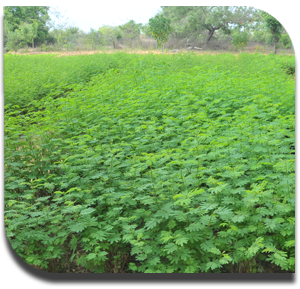
- Desmanthus is a perennial crop.
- It is grown throughout the year under irrigation and during June - October as a rainfed crop.
- Sow the seeds at 20 kg/ha in solid stand on the side of the ridges over the lines where fertilizers are applied at a depth of 2 cm and cover with soil.
- Irrigate immediately after sowing, life irrigation on the third day and thereafter once in a week.
- First cut on 90th day after sowing at 50 cm height and subsequent cuts at intervals of 40 days at the same height.
- Green fodder yield is 80-100 t/ha/year.
3. Lucerne
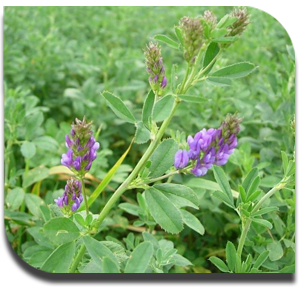
- Lucerne is also termed `Queen of forages'.
- It is a deep rooted perennial forage legume adapted to a wide range of conditions ranging from tropical to alpine.
- It is very palatable and nutritious forage legume containing 15 - 20% crude protein on dry matter basis
- Lucerne adds nitrogen to soil and improves soil fertility.
- It is grown for green fodder, hay, silage but does not tolerate close grazing.
- Varieties include Anand 2, Sirsa - 9, IGFRI S - 244, and Co 1.
- Variety Co1 is suitable for growing during July - December.
- Not suitable for very hot and very cold climates.
- Recommended seed rate --20 kg/ha.
- First harvest 75 - 80 days after sowing. Subsequent harvests are made at intervals of 25 - 30 days.
Characters of Variety Co 1:
- Green fodder yield (t/ha/year)- 70-80 (In 10 harvests)
- Seed yield (kg/ha)- 200 -250
- Protein content (%)- 20 - 24
- Dry matter (%)- 18 - 20
- Plant height (cm)- 60 - 80
- Mean clusters per tiller- 12 - 15
- Mean No. of pods per tiller- 22 - 25
- Mean No. of seeds per pod- 4 -6
4. Stylo
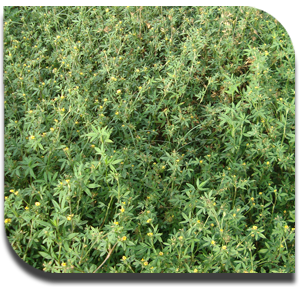
- Stylo is an erect growing perennial forage legume native of Brazil.
- It grows 0.6 to 1.8 m tall.
- Stylo is adapted to tropical climate and tolerant to low fertility soils, acidic soils and soils with poor drainage.
- Stylos are drought resistant legumes coming up well in areas receiving a minimum rainfall of 450 - 840 mm annually.
- The crude protein content of stylos ranges from 15 to 18%.
- Season is June - July to September - October.
- For line sowing (30 x 15 cm), the seed rate is 6 kg/ha and for broadcasting 10 kg/ha.
- First harvest can be taken 75 days after sowing at flowering stage and subsequent harvests depending upon the growth.
- It is to be noted that during the first year, the establishment after sowing is very slow and the yield is low.
- Later on when the crop establishes well due to self seeding it yields 30 to 35 t/ha/year from the third year onwards.
- Stylo is a good pasture legume.
TOP
Cereal Fodders
1. Fodder maize – Makkacholam
- Maize is an annual crop.
- It is grown on a variety of soils, but well drained fertile soils are best suited.
- Maize is mostly grown as KHARIF crop i.e. sowing in June - July. In south India it makes best growth in RABI and also in SUMMER.
- It can be grown throughout the year with irrigation facility.
- African tall, Vijay composite, Moti composite, Ganga - 5 and Jawahar are some important fodder varieties.
- Maintain a seed rate of 40 kg/ha and dibble one seed to a spacing of 15cm between the seeds in the row which are 30 cm apart.
- The average green fodder yield is 40-50 t/ha and the dry matter yield is 10-15 t/ha.
- Staggered sowing is recommended for supply of green fodder for a long period.
- Harvest the crop when the cob is in the milky stage.
2. Fodder sorghum - Cholam / Jowar
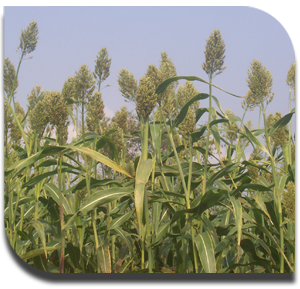
- It is cultivated mainly for grain and also for fodder.
- Sorghum is a drought resistant annual crop.
- It thrives in tropical climate with a temperature range of 25-35oC.
- It is not suited to higher elevations (more than 1200 m).
- It can be grown under an annual rainfall of 300-350 mm.
- It can be grown on any soil except on very sandy soils.
- Suitable varieties for irrigated area (Jan - Feb and Apr - May) are Co.11, Co. 27, Co.F.S. 29
- Suitable varieties for Rainfed conditions (Jun - Jul) are Co.11, Co27, Co.F.S.29
- Suitable varieties for Rainfed conditions (Sep - Oct) are K7, Co.27, Co.F.S. 29,K 10
- Co.F.S. 29 is a multicut variety and released by Tamil Nadu Agricultural University during 2001. It is cross between TNFS 9602 and Sudan grass.
- Seed rate is 40 kg/ha (only 12.5 kg/ha for Co.F.S. 29).
- Sorghum can be harvested after flowering stage for green fodder.
- If it is a single cut, it should be harvested at 60-65 days (50% flowering) after sowing and if it is a multicut, the first cut is 60 days after sowing and subsequently once in 40 days.
- For Co. F.S. 29, each harvest has to be done at 65 days interval (5 harvests in a year).
TOP
Grass Fodders
1. Hybrid Napier - Cumbu Napier Ottupull / Bajra Napier Hybrid:

- This is a perennial grass fodder.
- It possesses more tillers and leaves than Napier grass and is more vigorous and higher in fodder yield and quality.
- Crude protein ranges from 8 to 11%.
- Co.CN4 is a recent hybrid Napier grass released by TNAU, Coimbatore, which is a cross between Cumbu Co.8 and Napier grass F.T.461. Yield range is 380-400 tons/ha. It produces more tillers with soft and juicy stem, free from pest and diseases and non-lodging. It can be cultivated throughout the year under irrigated conditions.
- KKM-1 Cumbu Napier: This is a hybrid grass that gives average green fodder yield of 288 tonnes per ha per year. The quality is good with high calcium, magnesium and phosphorus and very low oxalate content.
- Pusa Giant, NB 21, NB 37, IGFRI 5, IGFRI 7 and IGFRI 10 (developed from Indian Grassland Research Institute, Jhansi) are superior hybrids developed in India.
- Co1, Co2 and Co3 are also superior varieties released from Tamil Nadu Agricultural University. These varieties are suitable for growing throughout the year in all districts of Tamil Nadu.
- 40,000 slips are required to plant one hectare.
- First harvest is to be done on 75 to 80 days after planting and subsequent harvests at intervals of 45 days.
- HN grass can be intercropped with Desmanthus at 3:1 ratio and can be harvested together and fed to the animals.
2. Guinea grass
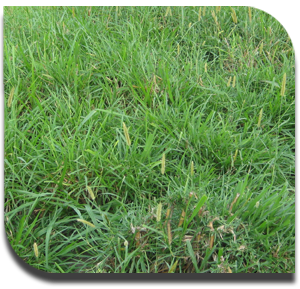
- It is a tall (1-4.5 m), tufted and fast growing highly palatable perennial grass.
- It has short creeping rhizome.
- Establishes readily by seed or plantation of rooted slips.
- Crude protein ranges from 4 to 14%.
- Hamil, PPG -14, Makuni, Rivers-dale are some of the varieties.
- Co1 and Co 2 are varieties of guinea grass released by Tamil Nadu Agricultural University.
- Suitable for all types of soil with good drainage.
- Does not come up well on heavy clay soil or flooded or waterlogged conditions.
- Seed Rate: Seed 2.5 kg/ha , Slips 66,000 nos./ha
- Spacing: 50 x 30 cm.
- First cut 75- 80 days after germination or 45 days after planting of slips. Subsequent cuts at intervals of 45 days.
- Green fodder yield is 175 tonnes /ha per year in 8 cuts.
- Guinea grass can be intercropped with Hedge Lucerne (Velimasal) at 3:1 ratio and can be harvested together and fed to the animals.
3. Para Grass - Neerpull / Thanneerpull / Erumai pull:

- It is a perennial grass suitable for cultivation in humid areas.
- It is grown in seasonally flooded valleys and lowlands and can withstand water logging and long term flooding.
- It cannot grow on dry lands in arid or semi - arid areas.
- It is sensitive to cold and makes little or no growth during winter months in sub-tropical regions of India.
- Water logged soils are best suited for this crop.
- It can be grown on sandy soils also, provided water supply is sufficient.
- Seed setting is very poor in this grass. It is propagated exclusively by stem cuttings.
- It can be planted at any time in South Indian conditions, but June - July planting is advisable under rainfed.
- There are no improved varieties of this grass (only local).
- Thin shoots are used as planting material. Stems with 2-3 nodes are planted in 45-60 cm rows at 20 cm spacing. The stems are pressed into wet soil leaving the two ends sticking up.
- 800-1000 kg of stem cuttings are needed for planting one hectare.
- The first cut is taken 75-80 days after planting and the subsequent cuts at 40-45 days interval. Totally, 6-9 cuts can be taken in a year with an average green fodder yield of 80-100 t/ha.
- This grass is fed in the green form and is not suitable for conservation either as hay or as silage.
4. Blue buffel grass - Neelakolukattaipull Var. Co 1:
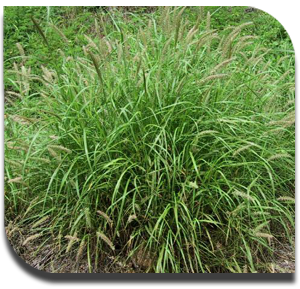
- This is a perennial grass highly suitable for pasture land.
- Cenchrus is a promising green grass type which performs well in dryland cultivation under rainfed conditions.
- Cenchrus cilliaris (Anjan grass) and C. setigerus (Black anjan grass) are the two commonly grown species but low yielding in nature.
- C. glaucus is yet another type found to grow well in dry land areas but superior than the other species.
- Well drained soil with high calcium content is suitable.
- Seed required is 6-8 kg/ha.
- First harvest on 70th or 75th days after sowing and subsequently 4-6 cuts depending on growth.
- A pure crop yields 40 t/ha/year in 4-6 cuts.
TOP
Tree fodders
1. Subabul - Soundal (Koobabul)

- This is fast spreading fodder tree which produces enormous seeds.
- Suitable season for sowing is June-July.
- Varieties- Hawaiian giant (lvory coast) and Co1.
- Rainfed: (Sep - Oct) K 8, Giant lpil – lpil and Co 1.
- Plants can be harvested in as early as 6 months after planting. However, the initial cutting should not be done until the trunk has attained at least 3 cm diameter or the plant has completed one seed production cycle.
- Harvests can be repeated once in 40 - 80 days depending upon growth and season.
- In drought prone areas, allow the trees to grow for two years to ensure deep root penetration before commencing harvest.
- The trees can be cut at 90 to 100 cm height from ground level.
- As green fodder under irrigated conditions, a pure crop yields about 80 to 100 t/ha of green fodder.
- Under rainfed conditions 40 t/ha of green fodder is got after 2 years of initial growth and pruning to a height of 100 cm.
2. Glyricidia
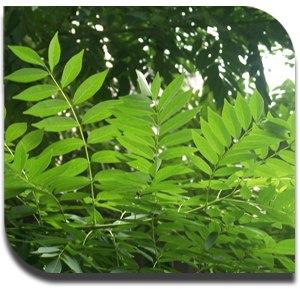
- It is a small, semi-deciduous tree with pale bark.
- Glyricidia sepium and Glyricidia maculata are the two species available.
- G. maculata is more useful as green leaf manure. It also fixes atmospheric nitrogen and thereby improves soil fertility.
- G. sepium tolerates a wide range of climatic and edaphic conditions. Growth is most rapid in regions where annual rainfall exceeds 900 mm, but it will grow where rainfall is as low as 400 mm per annum.
- It grows in soils ranging from heavy clays to sands and on rocky eroded sites; however, it is intolerant of water logging.
- The plant is used for fuel wood, animal feed, green manure, shade, poles, and living fences and as support plants.
- Used as an ornamental and as a shade tree for coffee.
- Propagated through seed or cuttings.
- It is able to produce profuse branching and fresh growth after every cutting.
- If cultivated along the border in one heactare, it will supply enough green leaf manure for 2 to 2.5 hectares of land.
3. Sesbania - Agathi
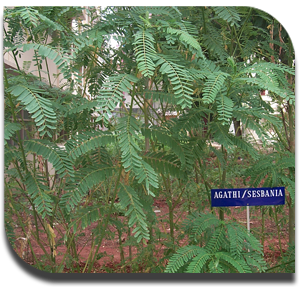
- The leaves of Sesbania trees are highly palatable and well liked by goats.
- The protein content in this is about 25%.
- Grown throughout the year under irrigation.
- Comes up in soils with good drainage.
- Seed rate is 7.5 kg /ha, sow the seeds at a spacing of 100 cm x 100 cm (100 cm between ridges and 100 cm between plants within the ridge).
- First cut after 8 months and subsequent harvests at an interval of 60-80 days.
- Green fodder yield of 100 tonnes per year is obtained from one hectare.
TOP
|











